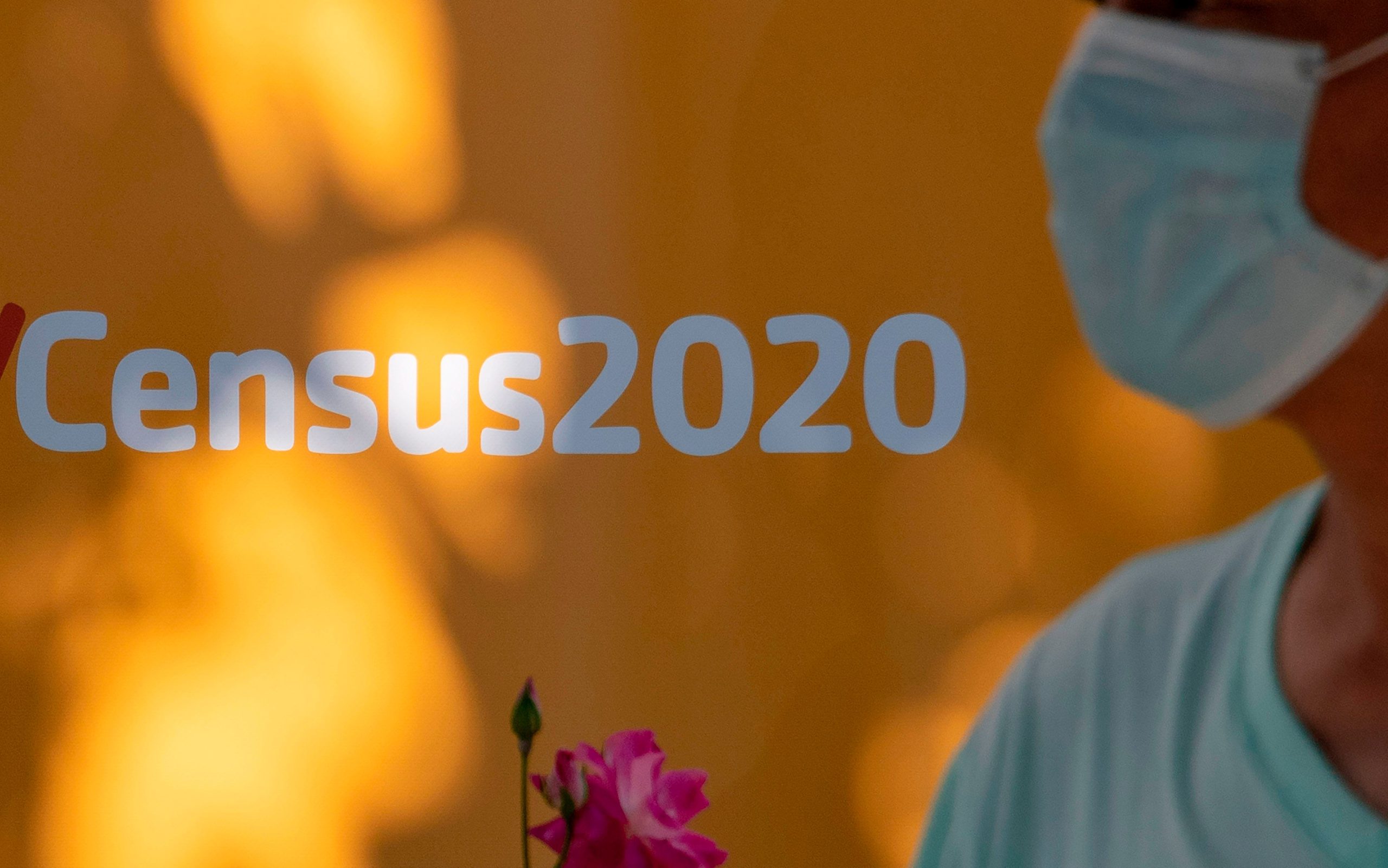

The United States experienced unprecedented multiracial population growth and a decline in the white population for the first time in the nation’s history, according to U.S. Census officials who released data Thursday, revealing the most sweeping picture of America’s racial and ethnic makeup in a decade.
“These changes reveal that the US population is much more multiracial, and more racially and ethnically diverse, than what we measured in the past,” said Nicholas Jones, the director of race, ethnicity, research and outreach for the Census Bureau's Population Division.
The white, non-Hispanic population, without another race, decreased by 8.6% since 2010, Jones said during a Census bureau press briefing. He cautioned that some of the changes can be attributed to improvements to the survey. The White, non-Hispanic population is still the largest racial group in the U.S.
The release bolstered expert predictions and estimates in past years that showed continued expansion of the Hispanic, Black and Asian American populations and growing numbers of multiracial residents – only a fraction in past surveys.
“The diversity that we're seeing in this country is going to be much more pronounced,” said William Frey, senior fellow at the Brookings Metropolitan Policy Program.
The statistics gleaned from the decennial census are used to hand out hundreds of billions annually in federal funding and for everything from drawing school district boundaries to measuring the diversity of police forces and corporate boards. The data can provide the bases for comparisons of the racial makeup of certain populations or the American population as a whole.
Race and ethnicity in America
In 2020, 33.8 million people reported being more than one race. A small fraction of residents reported being multiracial in 2000 (6.8 million, 2.4%), the first year respondents had the option. That share grew slightly in 2010 to 2.9% or 9 million people, according to the Census Bureau.
The 2020 Census used two separate questions to calculate race and ethnicity. One question focused on Hispanic or Latino origin. The other question focused specifically on race.
“The improvements and changes enable a more thorough and accurate depiction of how people self-identify, yielding a more accurate portrait of how people report their Hispanic origin and race within the context of a two-question format,” said Jones.
More:New Census numbers paint picture of race and ethnicity in U.S. But how are those defined?
Marc Perry, senior demographer at the Census Bureau, said slow population growth noted in counts released earlier this year carried over into state results released Thursday.
“The slowdown in growth is even more pronounced at the county level,” he said. “Fifty-two percent of all counties had smaller counties in 2020 than in 2010.”
He said smaller counties generally lost population while large ones gained.
“Population decline was widespread this decade,” Perry said.
Growth was “almost entirely” in metro areas, he said, adding that all 10 of the country’s most populous cities grew.
What is the census?
The results from the 2020 census, taken amid the pandemic and partisan sniping about the politicization of the process, are meant to be a snapshot of the population as of April 1, 2020. States use the census data to determine legislative and congressional districts – and the Electoral College votes that come with them. As Census officials explained in July, the data also will provide far-reaching insights and impacts.
Compared with the results from 2010 and earlier surveys, the data show Americans how the population has grown and changed and moved, as well as who our neighbors and communities are – in some sense what it means to be American today.
The census is mandated by Article I, Section 2 of the Constitution. Every ten years, the U.S. Census Bureau conducts a count of the American population, including key demographic details such as race and gender. These data, in turn, are used to draw up congressional districts, as well as in a host of other ways.
“It's sort of like the denominator for a whole lot of stuff,” said John Logan, a sociology professor at Brown University and population studies researcher. He likened it to a definitive “yard stick” Americans will use for years to come.
More detailed race data expected
Census results released this year gave Texas two more seats in Congress and one more each to Colorado, Florida, Montana, North Carolina and Oregon. Seven states lost a seat: California, Illinois, Michigan, New York, Ohio, Pennsylvania and West Virginia.
The more detailed results Thursday show how many people live in each county, city or town, down to individual blocks. The data show their ethnic and racial makeup and how many are over 18 – voting age.
The results present more comprehensive data on race and ancestry than in earlier surveys. The 2020 questionnaire included write-in boxes for Black or African American respondents for the first time, allowing them to list whether they are Haitian or Jamaican or Somali, for example. The surveys included similar boxes for white residents, allowing them to write in Lebanese or Egyptian or Italian.
The number of write-in responses that could be counted per individual has expanded – up to six were counted this time, versus two in 2010, according to officials.
The most diverse youth population in the nation’s history?
In years past, data from the census – taken nationwide every 10 years – showed which populations were growing and at what rates.
“In 2001, one of the questions was whether Hispanics were going to be outrunning African Americans as the largest American minority group, and it was close, and it depended on how you counted people,” Logan said. “But by 2010, there was no contest anymore because Hispanics have been growing, and African Americans as a population have not much.”
A Pew Research report in 2018 showed that Gen Z, which Pew defined as anyone born after 1996, was the most diverse generation and that nearly half of Gen Z identified as people of color. A bare majority of Gen Z is white, non-Hispanic, according to the report.
“The diversity that we're seeing in this country is going to be much more pronounced for this younger population,” said William Frey, senior fellow at the Brookings Metropolitan Policy Program. “And in fact, people of color will be responsible for any growth we have in the younger population.”
In 2018, 14% of the American population were immigrants, according to the American Immigration Council. The Pew Research Center reported that the 2018 immigrant population was the highest level on record since 1890.
“When we're looking ahead, we need to keep our eye on making sure that we have reasonable immigration levels,” Frey said. “It's going to keep our labor force age population from declining and our youth population declining.”
Undercount of marginalized communities
The coronavirus pandemic could mean thousands of Black and Latino communities were undercounted in the census. Advocates point out President Donald Trump’s attempt to include a citizenship question on the census – a departure from census questioning over several decades – as another factor increasing the undercount of people of color.
In general, undercounting is not new to the census. Data collections have generally undercounted hard-to-reach communities.
After the 2010 census, the bureau released a post-enumeration survey that showed it undercounted 2.1% of the Black population that year and undercounted 1.8% of the Black population in 2000. In 2010, the bureau undercounted 1.5% of the Hispanic population, and in 2000, the estimated undercount of the Hispanic population was 0.7% – not statistically different from zero.
According to a tally by a researcher at George Washington University, more than 300 federal programs in 2017 relied on data derived from the census to help guide distribution of $1.5 trillion to state and local governments, nonprofit groups, businesses and households, including certain USDA programs that are available only in rural areas.
“And the census data will let communities know if they're eligible or not,” said Andrew Reamer, the professor who led the research. “Conversely, for certain HUD (Housing and Urban Development) programs, you (a community) have to be big enough to be eligible."
Terry Ao Minnis, senior director of census and voting for Asian Americans Advancing Justice, said it’s critical for communities of color to be accurately counted during the census because of the funding opportunities via congressional representation.
“If our communities do not have a voice with their elected official, then their needs will not be addressed,” Ao Minnis said. “And this harm is amplified by the fact that these lines will be in place for the entire decade.”
Supreme Court says federal judges can’t block gerrymandering
In 2019, the Supreme Court’s Rucho vs. Common Cause ruling blocked federal judges from intervening in partisan election maps, essentially allowing gerrymandering.
The high court’s ruling “really set the stage for a very ominous redistricting cycle, especially for communities of color in the South, where redistricting once again will be controlled largely by one party,” said Michael Li, senior counsel for the nonpartisan Brennan Center for Justice's Democracy Program.
More:Supreme Court says federal courts cannot strike down partisan gerrymandering
Redistricting is the once-in-a-decade process of redrawing congressional districts to better reflect shifts in the populations. Redistricting is controlled by individual states.
“Because of residential segregation, it’s easier to break apart or pack together communities of color into districts in order to make the map more Republican,” Li said.
The National Black Justice Coalition partnered with the Census Bureau to reach out to increase participation of Black LGBTQIA+ individuals in filling out the census forms.
“As we think about state legislatures who will aggressively use this data to redraw congressional districts and boundaries and contribute to voter suppression, I worry greatly about what this will mean for democracy and attempts to weaponize data to chip away at democracy,” said David Johns, the executive director of the National Black Justice Coalition.
Politics 101:What is gerrymandering? Redistricting means new winners and losers
Voto Latino CEO and President Maria Teresa Kumar is concerned that census data could be used to disenfranchise Latino voters.
Kumar pointed out that three years after the 2010 census, the Supreme Court ruled in Shelby County v. Eric Holder to free states with a history of racial discrimination from having to clear voting procedure changes with the federal government.
“It turned out that Shelby County had had the second-largest population growth of Latinos in the country. They had experienced a 297% increase in the Latino population,” Kumar said.
Republican strategist Karl Rove declared in 2010 that “he who controls redistricting, can control Congress.” The Republican Party went on to win state legislative and gubernatorial races across the country.
According to the nonpartisan Cook Political Report, Republicans control the redistricting process in 17 states, Democrats in seven. The power is split between the parties in a half dozen states. Fourteen have independent commissions, mostly appointed by legislative leaders. Six states do not need to divvy up districts because they have only one seat in the House.
Cook Political Report analyst Dave Wasserman noted this year that Republicans have to pick up only five seats to win back control of the House of Representatives. Heestimated Republicans are positioned to pick up the equivalent of 3½ seats from Democrats through the redistricting process alone.
A slew of lawsuits could follow data release
Democracy Docket, a site founded by Democratic lawyer Marc Elias, is tracking redistricting lawsuits in Alabama, Illinois, Louisiana, Minnesota, Michigan, Ohio, Oregon and Pennsylvania.
Cases in Pennsylvania, Minnesota and Louisiana allege the census data released in April shows population shifts that render districts instantly unconstitutional.
Democracy Docket alleges Republican lawmakers often pass “unfair and unconstitutional maps,” and “some of the best protection voters have against disenfranchisement is through the courts.”
The National Republican Redistricting Trust, which coordinates GOP efforts on a national redistricting strategy, says on its site that Democrats plan to use redistricting “to gerrymander their way into permanent majorities, so they can enact their radical left-wing agenda unchecked.”
For Li, the future of the nation is a multiracial and coalitional electorate.
“In an ideal world, both parties would recognize that the future of the country is multiracial and coalitional,” Li said. “And both parties would say, ‘Well, how do I build a multiracial coalition?’”
Source link







